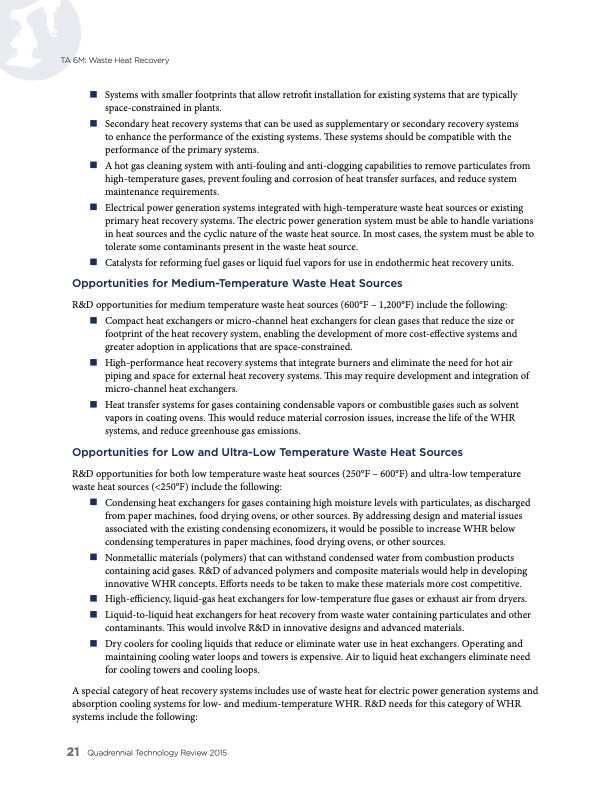
PDF Publication Title:
Text from PDF Page: 022
TA 6M: Waste Heat Recovery Systems with smaller footprints that allow retrofit installation for existing systems that are typically space-constrained in plants. Secondary heat recovery systems that can be used as supplementary or secondary recovery systems to enhance the performance of the existing systems. These systems should be compatible with the performance of the primary systems. A hot gas cleaning system with anti-fouling and anti-clogging capabilities to remove particulates from high-temperature gases, prevent fouling and corrosion of heat transfer surfaces, and reduce system maintenance requirements. Electrical power generation systems integrated with high-temperature waste heat sources or existing primary heat recovery systems. The electric power generation system must be able to handle variations in heat sources and the cyclic nature of the waste heat source. In most cases, the system must be able to tolerate some contaminants present in the waste heat source. Catalysts for reforming fuel gases or liquid fuel vapors for use in endothermic heat recovery units. Opportunities for Medium-Temperature Waste Heat Sources R&D opportunities for medium temperature waste heat sources (600°F – 1,200°F) include the following: Compact heat exchangers or micro-channel heat exchangers for clean gases that reduce the size or footprint of the heat recovery system, enabling the development of more cost-effective systems and greater adoption in applications that are space-constrained. High-performance heat recovery systems that integrate burners and eliminate the need for hot air piping and space for external heat recovery systems. This may require development and integration of micro-channel heat exchangers. Heat transfer systems for gases containing condensable vapors or combustible gases such as solvent vapors in coating ovens. This would reduce material corrosion issues, increase the life of the WHR systems, and reduce greenhouse gas emissions. Opportunities for Low and Ultra-Low Temperature Waste Heat Sources R&D opportunities for both low temperature waste heat sources (250°F – 600°F) and ultra-low temperature waste heat sources (<250°F) include the following: Condensing heat exchangers for gases containing high moisture levels with particulates, as discharged from paper machines, food drying ovens, or other sources. By addressing design and material issues associated with the existing condensing economizers, it would be possible to increase WHR below condensing temperatures in paper machines, food drying ovens, or other sources. Nonmetallic materials (polymers) that can withstand condensed water from combustion products containing acid gases. R&D of advanced polymers and composite materials would help in developing innovative WHR concepts. Efforts needs to be taken to make these materials more cost competitive. High-efficiency, liquid-gas heat exchangers for low-temperature flue gases or exhaust air from dryers. Liquid-to-liquid heat exchangers for heat recovery from waste water containing particulates and other contaminants. This would involve R&D in innovative designs and advanced materials. Dry coolers for cooling liquids that reduce or eliminate water use in heat exchangers. Operating and maintaining cooling water loops and towers is expensive. Air to liquid heat exchangers eliminate need for cooling towers and cooling loops. A special category of heat recovery systems includes use of waste heat for electric power generation systems and absorption cooling systems for low- and medium-temperature WHR. R&D needs for this category of WHR systems include the following: 21 QuadrennialTechnologyReview2015PDF Image | Innovating Clean Energy Technologies in Advanced Manufacturing

PDF Search Title:
Innovating Clean Energy Technologies in Advanced ManufacturingOriginal File Name Searched:
QTR2015-6M-Waste-Heat-Recovery.pdfDIY PDF Search: Google It | Yahoo | Bing
NFT (Non Fungible Token): Buy our tech, design, development or system NFT and become part of our tech NFT network... More Info
IT XR Project Redstone NFT Available for Sale: NFT for high tech turbine design with one part 3D printed counter-rotating energy turbine. Be part of the future with this NFT. Can be bought and sold but only one design NFT exists. Royalties go to the developer (Infinity) to keep enhancing design and applications... More Info
Infinity Turbine IT XR Project Redstone Design: NFT for sale... NFT for high tech turbine design with one part 3D printed counter-rotating energy turbine. Includes all rights to this turbine design, including license for Fluid Handling Block I and II for the turbine assembly and housing. The NFT includes the blueprints (cad/cam), revenue streams, and all future development of the IT XR Project Redstone... More Info
Infinity Turbine ROT Radial Outflow Turbine 24 Design and Worldwide Rights: NFT for sale... NFT for the ROT 24 energy turbine. Be part of the future with this NFT. This design can be bought and sold but only one design NFT exists. You may manufacture the unit, or get the revenues from its sale from Infinity Turbine. Royalties go to the developer (Infinity) to keep enhancing design and applications... More Info
Infinity Supercritical CO2 10 Liter Extractor Design and Worldwide Rights: The Infinity Supercritical 10L CO2 extractor is for botanical oil extraction, which is rich in terpenes and can produce shelf ready full spectrum oil. With over 5 years of development, this industry leader mature extractor machine has been sold since 2015 and is part of many profitable businesses. The process can also be used for electrowinning, e-waste recycling, and lithium battery recycling, gold mining electronic wastes, precious metals. CO2 can also be used in a reverse fuel cell with nafion to make a gas-to-liquids fuel, such as methanol, ethanol and butanol or ethylene. Supercritical CO2 has also been used for treating nafion to make it more effective catalyst. This NFT is for the purchase of worldwide rights which includes the design. More Info
NFT (Non Fungible Token): Buy our tech, design, development or system NFT and become part of our tech NFT network... More Info
Infinity Turbine Products: Special for this month, any plans are $10,000 for complete Cad/Cam blueprints. License is for one build. Try before you buy a production license. May pay by Bitcoin or other Crypto. Products Page... More Info
| CONTACT TEL: 608-238-6001 Email: greg@infinityturbine.com | RSS | AMP |